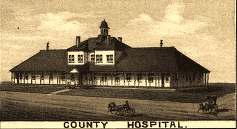|
The impact of the Railroad can hardly be understated. Owen Wister's The Virginian, Horseman of the Plains
is set in the period from the mid 1870's to 1890. Twelve years later, in 1902, in his
dedication of the novel to his friend and classmate, Theodore Roosevelt, Wister lamented:
Had you left New York or San Francisco at ten o'clock this morning,
by noon the day after to-morrow you could step out at Cheyenne.
There you would stand at the heart of the world that is the subject
of my picture, yet you would look around you in vain for the reality.
It is a vanished world. No journeys, save those which memory can take,
will bring you to it now. The mountains are there, far and shining, and
the sunlight, and the infinite earth, and the air that seems forever the
true fountain of youth, but where is the buffalo, and the wild antelope,
and where the horseman with his pasturing thousands? So like its old
self does the sage-brush seem when revisited, that you wait for the
horseman to appear.
But he will never come again. He rides in his historic yesterday.
You will no more see him gallop out of the unchanging silence than
you will see Columbus on the unchanging sea come sailing from Palos
with his caravels.

Presaging by ten years the comments of Wister above, were the observations
of Julian Ralph (1853-1903) in an article in Harper's New Monthly, June 1893, "Wyoming--Another Pennsylvania":
The
State has a population of only about
65,000, and only one town that is well
known all over the country. That, of
course, is Cheyenne, long the headquarters of the stockmen of the West, and
once a very wild and wide-open city.
It is not easy now to see where it stowed
its wickedness as one walks its tree-lined
streets bordered by pretty homes and trod
by a sober and self-respecting population.
Cheyenne has 12,000 population, strong
banks, good schools, notable churches
some large and enterprising mercantile
establishments, a fine park, and a great
State capital. The town languishes. Not
that the people regret the loss of the dance-
houses and gambling lay-outs, but because
the vim has gone out of business. The
range cattle industry is failing, and the
railroads have opened up other centres
where mining and agriculture are the
chief interests. But Cheyenne is like
Wyoming itself, in a transition state, and
its future is far more glorious than the
noisy, profligate, and unnatural past.
Julian Ralph was in the late 19th Century a well known travel writer and reporter, achieving
attention for his coverage of the Henry Ward Beecher trial, writing for
the New York Sun, the New York Herald and the Brooklyn Eagle. He achieved
his greatest fame, however, as a war
correspondent in the Boer War for the London Daily Mail covering Lord Roberts' raising of the flag over Pretoria.

At the time of the above images, Cheyenne had 7 churches,
Catholic, Presbyterian, Baptist, Congregational,
Episcopal, Methodist and African Methodist. The three-story building in the center of the close-up view
is the Inter-Ocean Hotel, owned by Barney Ford, discussed on next page. The site is now
occupied by the Hynd's Building on the corner of 16th and Capitol. Other hotels
in the City included the Railroad Hotel, Dyer's Hotel, the Metropolitan, the Western Hotel, Key City House and
the Leighton House. A block further up "Hill" Street from the Inter-Ocean is
the next three-story building, the Opera House. The Cheyenne Club was located
on East 17th Street. The Club, in its fittings, was worthy of many a "Gentlemen's Club" any
place within the British Empire to which some of its members owed allegience. Its membership included some of the owners of the largest
ranches in the State and, rightly or wrongly, it has been alleged that the
plans for the Johnson County War were formulated within its precincts.
Cheyenne Photos continued on next page.
|